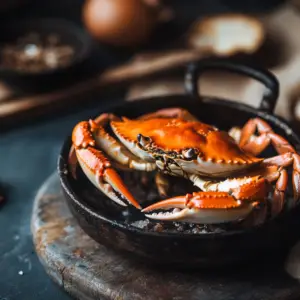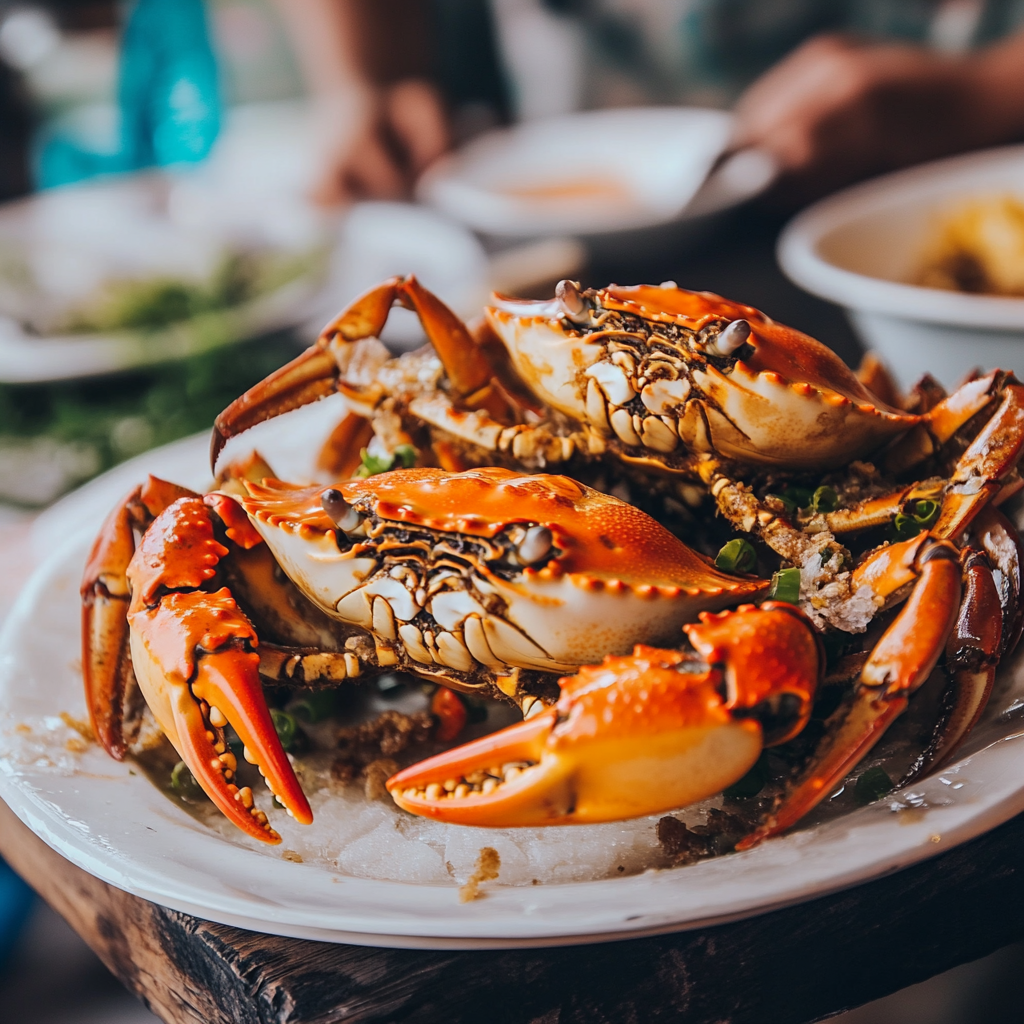Crab lovers around the world agree—there’s nothing quite like the sweet, tender meat of a well-prepared crab. With so many species available, you might wonder, Which crab tastes the best? The answer depends on your preference for flavor, texture, and cooking method. In this guide, we will explore the most delicious crabs and the key factors that make them stand out.
Different Types of Crabs
Common Crab Species
Several popular crab species offer distinct tastes and textures. These are some of the most commonly consumed crabs:
- Blue Crab: Famous for its sweet, delicate flavor, it is often used in Maryland Crab Cakes.
- Dungeness Crab: Known for its full-bodied, tender meat, Dungeness Crab offers a balanced flavor.
- King Crab: Loved for its firm, rich meat, King Crab is often considered a luxury.
- Snow Crab: While not as sweet as Blue or Dungeness Crabs, it delivers a subtle, satisfying flavor.
- Stone Crab: Known for its uniquely sweet claws and firm texture.
- Peekytoe Crab: A lesser-known variety with a mild, slightly nutty flavor.
Regional Varieties and Flavors
The flavor of crabs varies greatly depending on where they are harvested. Cold-water crabs, such as King and Snow Crabs from Alaska, tend to have a firm, dense texture, whereas warm-water crabs, like Stone Crabs from Florida, offer a milder, sweeter taste. Choosing sustainable seafood is important to ensure these delicious crabs remain available.
The Best Tasting Crabs According to Experts
Blue Crab: A Delicate Sweetness
Blue Crabs, especially those from the Chesapeake Bay, provide one of the best-tasting experiences. Their sweet, tender meat makes them ideal for steaming or incorporating into Maryland Crab Cakes. Though their smaller size means more work to extract the meat, the flavor is well worth it.
Dungeness Crab: Full-Bodied and Tender
Dungeness Crabs offer a perfect balance of sweetness and texture. They have a stronger flavor than Blue Crabs, making them a favorite for grilling or baking. Since Dungeness Crabs are larger, they provide plenty of juicy, tender meat for you to enjoy.
King Crab: A Rich and Firm Delight
Many consider King Crab to be the king of crabs, thanks to its rich flavor and firm texture. Alaskan King Crab, in particular, has a luxurious taste that is hard to beat. Often served simply with melted butter, King Crab’s sweet meat makes it a favorite for special occasions.
Cooking Methods for Crabs

Steaming vs. Boiling
When it comes to cooking crabs, both steaming and boiling are popular methods. Each technique has its own benefits and can produce delicious results, but they do impact the flavor and texture of the crab differently. Let’s compare both methods to help you decide which one suits your taste preferences and cooking style.
Steaming Crabs: Preserving Natural Sweetness
Steaming is often considered the preferred method for cooking crabs because it helps retain the crab’s natural sweetness and moisture. The steam gently cooks the meat without over-saturating it, allowing the delicate flavors to shine through. This method is especially popular for Blue Crabs and Dungeness Crabs.
Advantages of Steaming:
- Preserves the natural sweetness of the crab meat.
- Retains the crab’s natural moisture without making it soggy.
- Enhances the texture, resulting in tender, juicy meat.
How to Steam Crabs:
- Fill a pot with about 1-2 inches of water and add a steamer basket.
- Season the water with salt, herbs, or Old Bay seasoning to infuse flavor into the steam.
- Bring the water to a boil and place the crabs in the basket.
- Cover and steam for 15-20 minutes, depending on the size of the crabs.
The result is perfectly cooked crab meat that tastes fresh, sweet, and light. It’s ideal for enjoying crabs with minimal seasoning, such as melted butter or lemon juice.
Boiling Crabs: Infusing Flavor
Boiling crabs is a faster and more flavor-packed method, as the crabs cook directly in seasoned water. This technique works well for crabs like Snow Crab and King Crab, as the boiling process allows the crabs to absorb additional flavors from the liquid, such as spices, herbs, and aromatics.
Advantages of Boiling:
- Infuses crabs with the flavors of the boiling liquid.
- Faster cooking method, especially for large batches.
- Perfect for highly seasoned dishes like seafood boils.
How to Boil Crabs:
- Fill a large pot with water and add plenty of seasonings (salt, lemon, garlic, onions, and spices like Old Bay or Cajun seasoning).
- Bring the water to a rolling boil.
- Submerge the crabs and cook for 12-15 minutes, depending on the size.
- Once cooked, drain the crabs and serve immediately.
Boiling crabs adds a bolder flavor to the meat, especially if you’re preparing them in a seasoned broth or for a Cajun-style seafood boil. The crabs take on the flavors of the water, which can be customized to your taste preferences.
Which is Better?
Choosing between steaming and boiling depends on your personal preference:
- If you want to experience the natural sweetness of the crab, opt for steaming. This method preserves the delicate flavor and texture of the meat, making it ideal for enjoying crabs with simple accompaniments like butter or lemon.
- If you prefer crabs with a bolder, seasoned taste, boiling is the way to go. It infuses the meat with the flavors of the cooking liquid, making it a great choice for more flavorful dishes like seafood boils.
Both methods have their strengths, so why not try both and see which one you like best? Whether you steam or boil, you’ll end up with delicious crabs that are perfect for any occasion.
Grilling and Baking

When you think about preparing crabs, steaming and boiling may come to mind first. However, grilling and baking crabs are excellent methods that can bring out entirely different flavors, adding a unique twist to this beloved seafood. Here’s why these methods work so well and how you can master them.
Grilling Crabs
Grilling crabs introduces a smoky, charred flavor that enhances the natural sweetness of the crab meat. The high heat from the grill helps lock in moisture, making the crab juicy and tender. Grilling is particularly effective for crabs like Dungeness and Blue Crabs.
Steps for Grilling Crabs:
- Pre-cook the crabs (boil or steam) to ensure they’re fully cooked before grilling.
- Brush the crabs with a mixture of olive oil, garlic, and fresh herbs.
- Grill over medium-high heat for about 5-7 minutes, turning halfway through.
- The shells should become slightly charred, and the crab meat will absorb the smoky flavors.
Grilling adds a deeper, richer taste to your crabs, making them perfect for pairing with robust sides like roasted vegetables or corn on the cob.
Baking Crabs
Baking crabs, on the other hand, draws out the rich, buttery flavor of the meat. This method allows you to season the crab with a variety of spices or sauces and cook it in its own juices. Baking is ideal for crabs like King Crab and Dungeness Crab, which have larger pieces of meat that can stand up to the oven’s heat.
Steps for Baking Crabs:
- Preheat your oven to 375°F (190°C).
- Place pre-cooked crab legs or whole crabs in a baking dish.
- Drizzle with melted butter, lemon juice, and sprinkle with seasoning (garlic, paprika, or Old Bay).
- Cover the dish with aluminum foil and bake for 10-15 minutes, or until heated through.
The result is a rich, flavorful crab dish with buttery, tender meat that practically melts in your mouth.
Grilling and baking crabs not only introduce different textures and flavors but also provide exciting new ways to enjoy your favorite seafood. Whether you prefer the smokiness of grilled crabs or the buttery richness of baked crabs, these cooking methods will elevate your crab experience to the next level.
Nutritional Information and Health Benefits
Crabs offer not only great taste but also significant nutritional benefits. They are packed with high-quality protein, essential vitamins, and omega-3 fatty acids, making them a healthy addition to any diet. Let’s break down the key nutrients found in crabs and how they benefit your health:
- Protein: Crabs are an excellent source of lean protein, which helps build and repair tissues and supports muscle growth.
- Omega-3 Fatty Acids: These essential fatty acids promote heart health, reduce inflammation, and improve brain function. Omega-3s are particularly abundant in crabs, helping lower the risk of chronic diseases.
- Vitamins: Crabs are rich in Vitamin B12, which supports nerve function and helps produce red blood cells. They also contain Vitamin A, which benefits eye health, and Vitamin C, which strengthens the immune system.
- Minerals: Crabs provide vital minerals such as copper, zinc, and selenium. These minerals play important roles in immune function, bone health, and antioxidant activity.
Incorporating crabs into your diet can support overall wellness, contributing to improved heart health, better brain function, and enhanced immune defenses. For more details on the benefits of omega-3 fatty acids, you can visit this resource on omega-3 health benefits.
Additionally, crabs are low in calories and fat, making them a great choice for anyone looking to maintain a balanced and healthy diet. Enjoying crabs regularly can help you stay on track with your nutritional goals without sacrificing taste.
FAQs
What is the Sweetest Tasting Crab?
Many people consider Blue Crab to be the sweetest, with its delicate, tender meat. Steaming enhances its natural sweetness, making it a favorite among crab enthusiasts.
Which Crab Has the Most Meat?
When it comes to meat quantity, King Crab takes the prize. Its legs are packed with firm, flavorful meat, which makes it one of the most popular crabs for seafood lovers.
How Do You Eat Crab for the First Time?
For first-timers, starting with a Dungeness or King Crab is recommended. These crabs are easier to handle due to their larger size. A crab cracker helps open the shell, and you can enjoy the meat with melted butter.
What is the Best Season to Eat Crabs?
Crab season varies depending on the species. For example, Blue Crabs are in season during the summer and fall, while King Crabs are typically harvested in colder months. For the freshest crabs, it’s best to check with local seafood markets.
Is Eating Crab Healthy?
Yes, crabs are a healthy addition to your diet. They are low in calories, high in protein, and rich in essential nutrients. Additionally, crabs are an excellent source of omega-3 fatty acids, which promote heart health and reduce inflammation.

Conclusion
Whether you prefer the delicate sweetness of Blue Crab, the full-bodied flavor of Dungeness Crab, or the rich, firm texture of King Crab, each species offers a unique tasting experience. By considering the flavor, texture, and preparation method, you can choose the best-tasting crab to suit your palate. Just remember to opt for sustainable seafood to ensure these crustaceans remain available for years to come.

